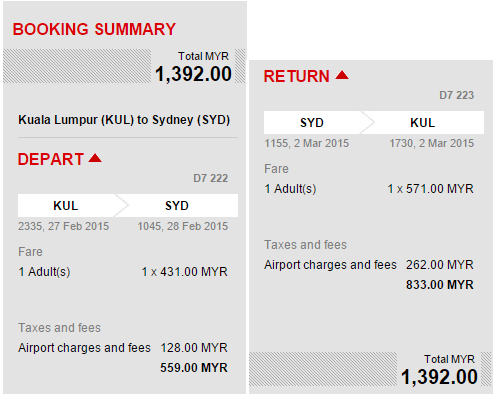This is not a great time for airlines, especially in this part of the world, due to the various disasters, and also the declining oil price.
The oil price slump has wrecked havoc in our economy, resulting in the country’s Budget 2015 revision and also the weakening Ringgit. However, for those who have caught the travel bug, you can now benefit from this.
AirAsia will be abolishing fuel surcharge effective January 26, 2015 across all of its airlines in the group, as well as its low-cost long haul affiliates AirAsia X, Thai AirAsia X and Indonesia AirAsia X, in line with declining global oil prices.
Update: Other airlines like FireFly and Malindo also abolished their fuel surcharge in line for the declining oil prices. The heat is now on Malaysia Airlines (MAS), but it is not clear if it will follow suit even though its peers like Japan Airlines and Cathay Pacific have done so.
How does fuel surcharge work?
A few years back when crude oil price was hovering around US$130 a barrel, there was only one word to describe the fuel surcharges charged by airlines, “madness”.
Today, oil has plummeted to less than US$48, and we are seeing airlines starting to drop the controversial fuel surcharge. And in this part of the world, we can enjoy cheaper flights sans fuel surcharge through AirAsia and all its affiliates.
AirAsia was the first airline to abolish fuel surcharge for all its domestic and international flights back in 2008, however rocketing fuel prices forced the airline to re-introduce fuel surcharge into its fares in 2011.
Fuel surcharges was introduced by many airlines in the early 2000s as the price of oil was on the rise, but they don’t bear much relation to how much fuel actually costs. They are arbitrary numbers that the industry adjusts to maximise their profits while staying competitive with other carriers.
“Fuel is the largest category of operating expense for the industry, representing around 30% to 33% of industry operating expenses,” said Mona Aubin of the International Air Transport Association, the trade association for the world’s airlines in an article published by CBC News.
As fuel is an inherent part of any airline’s operations, it’s a well-known secret for airlines to charge their passengers’ a “surcharge” for the costs of the captain and flight attendants.
Most of the time, passengers booking for flights won’t even notice the fuel surcharge, until they try to redeem their air miles or loyalty points. Under many frequent flyer programmes, you still have to pay the airport charges and fees, as well as, fuel surcharge.
How much would you save?
Prior to the abolishment of fuel surcharges, a flight to Sydney from Melbourne will cost you RM150 in fuel surcharge, while a trip to Krabi will set you back by RM43.
Here’s how much you have to pay for a Kuala Lumpur – Sydney return ticket:
With fuel surcharge, you will see yourself parting with RM1,692 to Sydney and back.
Why are airlines dropping fuel surcharge?
This waiver on fuel surcharge comes at the right time, with market confidence low for the company, and also air travel in the region overall.
According to AirAsia’s Group Chief Executive Officer, Tan Sri Tony Fernandes, “This decision has been made in November 2014, which was in line with declining global oil prices.
“However, we are only able to implement it now, but we believe removing fuel surcharge and reducing travel costs will be a huge boost to the tourism industry. This will be a plus point for consumers, but the economy will also benefit from this as the tourism industry is a great job creator.”
With the removal of fuel surcharge from its fares, guests will be able to find domestic flights from as low as RM19 one way all-in, and international flights from RM49 one way all-in.











